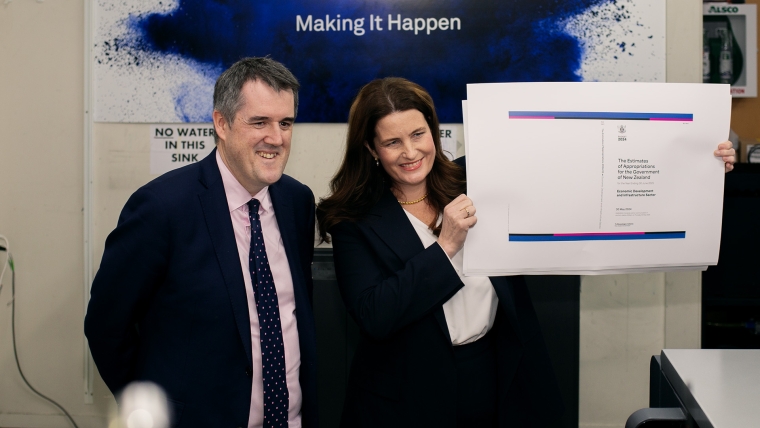
The Treasury says the Crown’s fiscal position improved in the year ended June after the slowest growth in Government spending since 2021 and a reduction in net capital outflows.
Financial accounts for fiscal year 2025 showed the Government’s total revenue up $2.5 billion to $170 billion and expenses climbing $3.4 billion to $184 billion.
This $13.7 billion spending gap was offset by a $8.7 billion gain on financial instruments, which brought the operating balance to a deficit of $4.4 billion from $8.4 billion last year.
The OBEGALx deficit increased to $9.3 billion from $8.7 billion in 2024. This measure excludes financial gains and losses and also the self-funding Accident Compensation Corporation.
It was designed to reflect changes in actual policy and is the Coalition’s preferred measure.
Income and other tax cuts, which took effect in this fiscal year, stymied efforts to balance the budget. Without them the operating deficit could have been just $700 million, ignoring possible economic effects.
Net core Crown debt climbed $6.7 billion to $182 billion but was $3.5 billion below forecast and was unchanged as percentage of the economy at 41.8% of gross domestic product.
Fiscal measures are best expressed as a percentage of GDP given nominal numbers increase steadily with the economy. Total revenue fell from 39.8% of GDP to 38.9%, expenses dropped from 42.9% to 42.1%, and OBEGALx held steady at 2.1%.
Most improved
Treasury said most fiscal indicators were showing signs of recovery after coming under enormous pressure during the pandemic.
“Following a period of large deficits and debt rising sharply, many of the Government’s key fiscal indicators this year are showing signs of improvement. The year-on-year growth in total expenses was the lowest it has been since 2021.”
The cash deficit, which dictates how much the Crown needs to borrow, plunged from $19.3 billion in fiscal year 2024 to just $6 billion in 2025. However, much of this change was due to accounting quirks rather than meaningful economic changes.
Retail banks repaid $9.3 billion of Funding for Lending Programme (FLP) loans which were issued by the Reserve Bank as part of pandemic stimulus between 2020 and 2022. Treasury said it was best to ignore this cash change as it was not available to fund Crown activities.
“So, when looking through the impacts from FLP, the residual cash shortfall for the year would be $15.3 billion at 30 June 2025 compared to $22.2 billion at 30 June 2024,” it said.
The FLP also created noise in the measures of capital spending. Net core Crown capital cash flows cratered from $13.2 billion to just $4.3 billion with the FLP repayments warping the numbers.
Underlying spending on physical assets and capital provided to Crown infrastructure entities did not change so dramatically. The former fell $1 billion and the latter increased $1.6 billion, although both were slightly below Budget 2024 forecasts.
Capital transferred to entities—such as NZTA or Kāinga Ora—doesn’t necessarily equal the infrastructure spending happening in the real economy during the fiscal year. Actual activity might be higher or lower depending on project timelines.
Treasury uses the operating balance (-$4.4b) as its main measure of fiscal performance and net worth as its measure of fiscal resilience, or balance sheet strength.
Net worth declined $1.9 billion to $189 billion as the operating deficit and increased veterans’ disability entitlements were not fully offset by valuation gains on existing assets.
Political spin
Overall, the financial statements show the Coalition has stopped growing government spending but has made minimal progress balancing the budget or reducing debt.
It aims to return to an OBEGALx surplus by 2028, reduce government spending to 30% of GDP, and put net core Crown debt on a downward path to 40% of GDP.
Finance Minister Nicola Willis said the accounts showed the Government was making progress in restoring fiscal discipline.
“We're investing more in health and education, but as a proportion of the overall economy, ground spending is reducing. That's necessary because of the huge debt and deficits that were built up under the last government,” she told reporters.
Treasury accounts showed health spending increased $300 million (although 2024 spending was abnormally elevated by one-off factors) while education rose $700 million. Spending on general government administration was reduced by $600 million.
Barbara Edmonds, the Labour Party’s finance spokesperson, said a reduction in capital spending had caused a decline in the construction sector and harmed the Crown accounts.
“If you have a look at some of the pages in there, there's an increase in government expenditure on social services, and that's because the job market and labour market is so weak,” she said.
“What [Nicola Willis] needed to do was smart investment. So, cutting back on capital spend, which therefore saw a loss of 20,000 construction sector roles. Of course, you're going to get higher unemployment, more people on social services.”
Treasury accounts showed core spending on social security and welfare was $47.6 billion in 2025, up $2.9 billion from 2024 and marginally higher than forecast.
The growth largely reflected benefits being indexed to inflation or wage growth, while the number of people receiving superannuation and jobseekers increased due to demographic changes and a weak labour market, the agency said.
An earlier version of this story incorrectly described the fall in net core Crown capital cash flows as being driven by infrastructure investment rather than Funding for Lending loan repayments.

We welcome your comments below. If you are not already registered, please register to comment.
Remember we welcome robust, respectful and insightful debate. We don't welcome abusive or defamatory comments and will de-register those repeatedly making such comments. Our current comment policy is here.